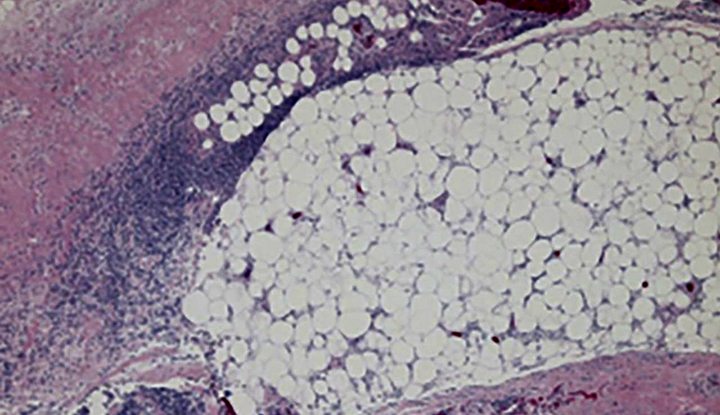Necrotizing fasciitis, also known as flesh-eating disease, is a bacterial infection that affects the tissue under your skin called fascia. It’s treated with antibiotics and surgery to remove damaged tissue.
Advertisement
Cleveland Clinic is a non-profit academic medical center. Advertising on our site helps support our mission. We do not endorse non-Cleveland Clinic products or services. Policy

Necrotizing fasciitis is a severe rapidly spreading bacterial infection that can cause death. The word “necrotizing” refers to something that causes the death of something else. The word “fasciitis” refers to inflammation of the fascia, which is the subcutaneous (under the skin) tissue that surrounds muscles and nerves and holds everything, including fat and blood vessels, in the correct position.
Advertisement
Cleveland Clinic is a non-profit academic medical center. Advertising on our site helps support our mission. We do not endorse non-Cleveland Clinic products or services. Policy
Necrotizing fasciitis is a form of necrotizing soft tissue infection (NSTI). Some people call necrotizing fasciitis or any NSTI the “flesh-eating disease.” Other NSTIs are necrotizing myositis and necrotizing cellulitis.
There are two types of necrotizing fasciitis: polymicrobial (also called Type I) and monomicrobial (also called Type II).
Polymicrobial necrotizing fasciitis is an infection caused by more than one type of bacteria, usually mixed anaerobic and aerobic bacteria. Monomicrobial necrotizing fasciitis is usually caused by group A Streptococcus or Staphylococcus aureus.
Certain people are at greater risk of developing necrotizing fasciitis. These are people who have:
The number of cases of necrotizing fasciitis is estimated to be 0.3 to 15 per 100,000 people, but this is likely less than the true number. Between 2010 and now, the number of reported cases of necrotizing fasciitis caused by group A strep bacteria ranged from 700 to 1,200 per year. These numbers are likely to be lower than the actual total number of cases of necrotizing fasciitis. Up to 1 in 3 people with necrotizing fasciitis die from the infection.
Advertisement
Early symptoms of this condition include signs and symptoms that resemble those of the flu:
The progression of necrotizing fasciitis is very quick. Later signs and symptoms include:
It’s important to seek care quickly if you have developed signs and symptoms of necrotizing fasciitis as this infection spreads fast.
The most common way to get necrotizing fasciitis is when bacteria invade your body through a cut in your skin, although it can happen if you have a trauma that doesn’t break the skin.
Ways that bacteria can enter your skin:
If your healthcare provider thinks you have flesh-eating disease, they may order diagnostic tests, including:
Your provider will perform surgery to diagnose necrotizing fasciitis. They'll also perform surgery to examine your skin and tissues and remove dead tissue (a process called debriding).
Quick intervention is needed to control necrotizing fasciitis. You’ll require exploratory surgery to confirm the diagnosis of necrotizing fasciitis. Surgery is also required to remove dead tissue. It may take multiple surgeries to control the infection and remove all of the dead tissue. It takes an average of three surgeries to make sure all of the infection is gone. Your provider will also likely prescribe antibiotics and intravenous (IV) fluids. After surgery, you may need skin grafts or plastic surgery to help the wounds close completely.
Many complications of necrotizing fasciitis are serious. They may include:
If you have this condition, your best outcome will come from receiving an accurate diagnosis and quick treatment with antibiotics combined with surgery to remove the dead tissue.
Necrotizing fasciitis (flesh-eating disease) gets worse quickly, destroying your tissue and causing things like organ failure. Even with treatment, 1 out of 3 people dies from this disease.
Advertisement
You may need more than one surgery to manage necrotizing fasciitis. You may have scarring.
Currently, there isn’t a vaccine to prevent necrotizing fasciitis. To reduce your risk of bacterial skin infections, including necrotizing fasciitis, from developing:
You should contact your healthcare provider if:
If you’ve been diagnosed with and treated for necrotizing fasciitis, and you aren’t getting better, contact your healthcare provider. Keep any follow-up appointments that your provider may schedule. If you’re taking antibiotics, make sure you take them as instructed.
The disease gas gangrene (clostridial myonecrosis) happens to healthy tissue and leads to gas in the tissues. This gas is a waste product given off by germs. You may get gas in your tissues from either gas gangrene or Type I necrotizing fasciitis. However, the germs that cause each disease are different. Gas gangrene may also involve muscles.
Advertisement
Necrotizing fasciitis is most often found on your limbs, fingers and toes. The lower extremities (toes, feet, etc.) are more likely to develop necrotizing fasciitis, especially if you have diabetes.
Other areas that are affected by necrotizing fasciitis include the genitals and head and neck area.
Yes, it’s possible to survive if you have necrotizing fasciitis. It’s important that diagnosis and treatment happen early.
Necrotizing fasciitis rarely spreads from one person to another. Therefore, it's usually not necessary to give antibiotics to close contacts. But, in cases of severe infection, your provider might recommend your close contacts take preventive antibiotics.
You may see symptoms of necrotizing fasciitis within 24 hours of getting scratched, bit, or cutting yourself. Necrotizing fasciitis gets worse quickly. Keep an eye out for areas that look swollen or red and that continue to get bigger.
If you have some type of wound, like a cut or burn, make sure that you clean it well with soap and water. If you develop a fever, severe pain and/or a red or discolored area that grows quickly and feels warm, get medical help immediately. You’ll have the best results with necrotizing fasciitis if you’re treated immediately.
Advertisement
Have a virus, fungus or bacteria? Some of these “bugs” won’t go away on their own. Cleveland Clinic’s infectious disease experts are here to help.

Last reviewed on 05/24/2022.
Learn more about the Health Library and our editorial process.